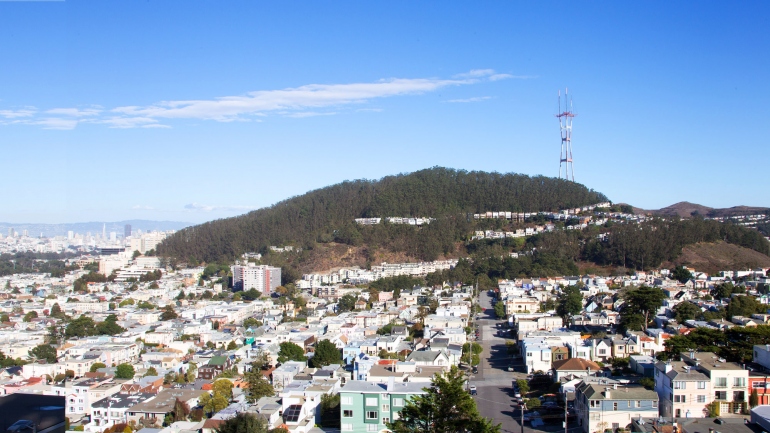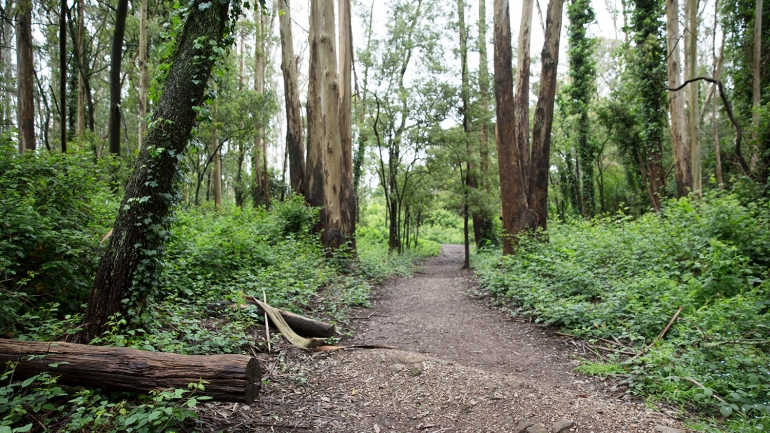UCSF Finalizing Plan to Restore Health of Mount Sutro Open Space Reserve
20-Year Management Plan is Widely Endorsed by Environmental, Conservation Groups
UC San Francisco is finalizing a long-term management plan for the Mount Sutro Open Space Reserve that will address the widespread damage wrought by the worst drought in modern California history.
A half-decade of severe drought, which officially ended last year, was followed by a heavy storm season, creating a devastating effect on the 61-acre Reserve, located south of UCSF’s Parnassus Heights campus. An independent survey confirmed that at least 23 percent of the Reserve’s trees are now dead or dying, creating unsafe conditions and threatening the overall health of the forest.

Management of Mount Sutro
UCSF began a public process more than two years ago to develop a management plan to protect the safety of the community, improve ecosystem health, regenerate the forest, and ensure public access.
The decline led UCSF to undertake a two-year process to develop a plan to improve the health and safety of its open space.
UCSF’s public process included hiring two forestry consultants to develop the plan and forming a Technical Advisory Committee comprised of local experts in forestry, hazard reduction, biology and habitat restoration to provide guidance on best practices in forest management. The committee held four public meetings to gather input on the development of the plan, followed by two community meetings and public tours of the Reserve.
“After a thoughtful and interactive process with experts and the community, UCSF has developed a much-needed plan to restore the health of the Mount Sutro Open Space Reserve,” the Sierra Club, which endorsed the final proposed plan, said in a statement.
Three Phases of Restoration
In developing the long-term management plan, UCSF had four main goals: 1) to protect the safety of residents and visitors, 2) improve ecosystem health, 3) regenerate the forest, and 4) maintain and ensure public access to the Reserve.
The resulting 20-year plan will address the decline in tree and ecosystem health in three phases. In the first five years, the focus will be on removing hazardous dead and dying trees and replanting in some of the hardest hit areas. The next two phases will target additional areas of decline by clearing out dead and dying trees and replanting both trees and other vegetation in those areas. UCSF will replant eucalyptus to restore the eucalyptus groves and also will plant native trees and other native species to improve biodiversity and ecosystem health.
The plan will be sent to UCSF Chancellor Sam Hawgood, MBBS, in mid-April for his signature. Once approved, UCSF is scheduled to begin the long-awaited restoration work after bird-nesting season ends in August 2018. The work will be done in phases with regular assessments throughout the process. UCSF will keep the community updated on the progress once implementation of the plan is underway.
Updates Following Environmental Review
Following its public process to develop the draft plan, UCSF prepared an Environmental Impact Report, as required under California’s Environmental Quality Act (CEQA). The environmental review determined that a few small variations to the original plan would be more beneficial to the overall health of the Reserve.

Initially, the plan proposed to replant only eucalyptus trees in the first five years. The alternative that emerged from the review process proposes a planting mix of 75 percent eucalyptus and 25 percent native species. Also, the plots for replanting will be smaller, shielded by native shrubs and further away from trails to improve the aesthetic experience and enjoyment of visitors.
“As an organization that works with dedicated volunteers every week to maintain and improve Mount Sutro, we are personally invested in the health and longevity of the Reserve. We see firsthand the need to manage the open space for long-term sustainability, and we support UCSF's plan to regenerate the Reserve to a healthy, diverse ecosystem for all to enjoy,” said Amy Kaeser, executive director of the Sutro Stewards, an independent network of volunteers dedicated to maintaining public access of the Reserve through trail maintenance, a native plant nursery and habitat conservation.
The proposed final plan has the broad support of leading environmental and conservation groups, including the Sierra Club, Nature Conservancy, Golden Gate Audubon Society, Sutro Stewards, San Francisco Department of the Environment, and neighborhood organizations.
“We are pleased to support UCSF’s Mount Sutro plan because of the extensive outreach and community support it has received,” according to a statement by the Board of the Inner Sunset Park Neighbors. “Inner Sunset neighbors frequently visit the Mount Sutro Open Space with their families to enjoy a respite from their busy urban lives, and the effects of the drought have become far more apparent during the past few years. We support the proposals to improve the conditions and safety of the Reserve so that it remains exceptional sanctuary we all know and love for generations to come.”